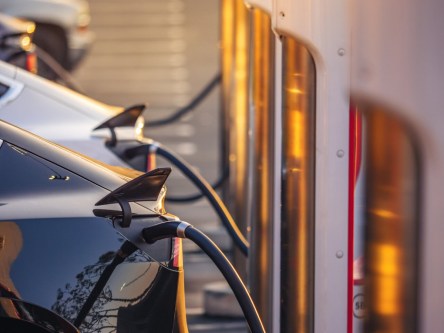Electric vehicles – and their charging apparatuses – are a hot topic. With electric vehicles accounting for only about 6% of U.S. new car sales in 2022, the country is one of the world’s largest markets for EVs. The federal government has set a goal of 500,000 EV charging stations at apartment buildings, public parking lots, roadways and other locations by 2030, up from 133,000 in 2020. At that point half of all road vehicles could be electric, if the government’s target is met. Owners of EVs, which use rechargeable lithium-ion batteries, spend 60% less each year on fuel costs compared to drivers of gas-powered cars, according to a Consumer Reports study in 2020. The federal government, most states and the District of Columbia offer tax credits and other incentives to install charging stations. California, for example, has provided $1.2 billion to build the infrastructure for EVs across the state. The state will also adopt regulations requiring EV charging station installation in the parking facilities of buildings, including hotels, multifamily buildings and nonresidential development, by 2025. Other states, including Arkansas and Florida, offer rebates for EV charging station installation and EV purchases. Approaching essential status One outgrowth of these and other trends is that EV charging stations are evolving into an essential asset for property managers. By installing EV charging stations, retail business, offices and workplace property managers gain opportunities to attract customers and tenants by demonstrating “their commitment to new technology and innovation,” says industry resource Property Manager Insider. “For multifamily and commercial properties, … the availability of reliable EV chargers is not just a nice-to-have, but a vital factor for retaining and attracting residents and tenants,” adds CleanTechnica, a clean energy news source. Key steps that property managers can take to stay...
Charged Up
ELECTRIC VEHICLES + ENERGY STAR
ENERGY STAR® certifications have gone mobile. Originally geared toward properties and consumer products, the U.S. Department of Energy’s (DOE’s) efficiency program now includes a scoring system for electric vehicle (EV) charging stations. In December 2016, the U.S. Environmental Protection Agency (EPA) finalized its inaugural ENERGY STAR specification for electric vehicle chargers. An ENERGY STAR-certified charging station is defined as using 40% less energy than an uncertified one. As EV technology increases its foothold in the marketplace, its capabilities and ENERGY STAR endorsement offer substantial cost, convenience and sustainability benefits. Moving toward EV-compatibility EV sales are expected to top 1 million by 2020, up from about 200,000 in 2017. Some observers predict EVs will be the dominant mode of propulsion for cars by 2030, making charging an increasingly significant value consideration for multifamily and commercial property owners. Driving EVs and using ENERGY STAR-certified chargers can produce: Savings—EVs cost about half as much to drive per mile than standard gasoline-powered vehicles, according to this calculator. Property owners hosting charging stations for tenants and customers can control costs by anticipating the need for new EV equipment, upgrading electrical service to accommodate it, taking operations and maintenance costs into account, and researching incentives that make installations easier and less expensive Efficiency—EVs convert about 59–62% of the electrical energy from the grid to power at the wheels, whereas conventional gasoline vehicles convert about 17%–21% of the energy stored in gasoline to power at the wheels Convenience—Most EV charging happens at home or work, giving property managers who offer this capability a competitive advantage. But what if those places aren’t available? Locate the nearest public charger location in the U.S. here Smart technology—Some ENERGY STAR-certified EV charger models use Wi-Fi technology for remote power monitoring and control of the charging state...
Largest EV Station
Charging in Germany
Automakers have been hard at work, developing ideas for the cars of the future, but in order for the new vehicles to have a future, a proper infrastructure needs to be designed and put into place. The battery industry is in full swing with more and more scientists getting involved into the development of bigger and better ones, but regardless of their capacity, they all need to be recharged. This means that charging stations need to spring in at least as many locations as the conventional gas stations. Sortimo, a German company headquartered in Berlin, unveiled plans of what’s to become the largest electric vehicle fast-charging station in the world—the Sortimo Innovationspark Zusmarshausen. The project will be located along Germany’s six-lane A8 highway, in the industrial area in Bavarian-Swabia, between Ulm and Augsburg, in close proximity to Tesla’s Supercharger in Jettingen-Scheppach. The electric vehicle (EV) fast-charging station will consist of 144 charging ports, which will allow for more than 4,000 cars to be refilled with energy on a daily basis. Of the planned charging columns, 24 are to be superfast chargers, with a charging capacity of record-breaking 350 kilowatts, meaning that a vehicle battery can be replenished in only a few minutes. Tesla’s ‘Superchargers’ currently stop at about 150 kilowatts, but even though this is more than what today’s car batteries can handle, the company is convinced that both battery capacities and the need for charging infrastructure are growing at a significant pace. Moreover, the Innovationspark will feature offices, shopping and dining areas, serving those who stop to recharge their vehicles. The images accompanying the announcement reveal that the planned station will be topped with green roofs, emphasizing on the development’s care for nature and awareness for the environment. The massive charging station will...



